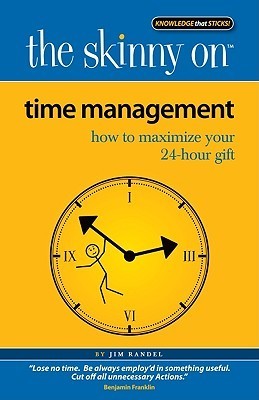
The Skinny on Time Management: How to Maximize Your 24-hour Gift
Book Description
Tick-tock—every second counts in the relentless race against time. In "The Skinny on Time Management," Jim Randel unveils a masterclass in mastering the 24-hour gift we all receive each day. Packed with practical wisdom and innovative techniques, this essential guide transforms chaos into clarity, helping you reclaim those precious hours lost in distraction and indecision. With a captivating blend of insight and actionable strategies, Randel empowers you to seize control, prioritize like a pro, and finally live the life you’ve always craved. What will you choose to create with the time you have left?
Quick Book Summary
In "The Skinny on Time Management," Jim Randel provides an accessible, illustrated guide to conquering time-related challenges and maximizing productivity in modern life. Using engaging narratives and stick-figure illustrations, Randel distills essential principles and practical tools for organizing tasks, setting priorities, and avoiding common pitfalls that waste our most precious resource—time itself. The book emphasizes self-awareness, discipline, and intentional action, guiding readers to identify time thieves, build effective routines, and break large goals into manageable steps. Randel’s approach demystifies the art of getting things done, encouraging readers not just to work harder but to work smarter. With actionable wisdom tailored for busy individuals, this book is a practical roadmap to optimizing every day and pursuing a more focused, fulfilling life.
Summary of Key Ideas
Table of Contents
Identifying and Eliminating Time Wasters
Jim Randel's "The Skinny on Time Management" opens by confronting the universal truth that time is a finite, non-renewable resource. Randel uses simple language and signature stick-figure graphics to illustrate how easily our days slip away through distractions and reactive behavior. He introduces the idea that the root of time-wasting often lies in a lack of clarity about what truly matters—and offers strategies for pinpointing where time vanishes on a daily basis. By encouraging readers to identify "time thieves"—those little habits or distractions that silently eat away at productivity—Randel sets the stage for greater mindfulness about how we choose to spend every hour.
The Importance of Prioritization and Focus
Building on this self-awareness, Randel highlights the critical importance of prioritization. He shares accessible frameworks, such as the Pareto Principle (80/20 rule), urging readers to distinguish between tasks that are urgent and those that are important. Through illustrations and case studies, he demonstrates how focusing on high-impact activities creates leverage, allowing people to achieve more by doing less. This section underscores that busyness does not equate to productivity; it’s about assessing which tasks drive real results and learning to say "no" to distractions or low-value demands.
Building Routines and Systems for Efficiency
The book then pivots to the practical side of building routines and systems. Randel advocates for the power of habits, checklists, and daily planning as tools to minimize decision fatigue and make productivity automatic. He offers suggestions for time-blocking, delegating repetitive tasks, and creating rituals that cue the brain into "work mode." The message is that strong systems create consistency, freeing up mental energy for creativity and critical thinking. Randel encourages experimenting with routines to find a personalized rhythm that maximizes energy throughout the day.
Setting Goals and Breaking Them Down
A crucial part of Randel's strategy involves goal-setting and deconstructing big ambitions into actionable steps. He argues that specificity breeds progress: instead of vague objectives, readers should break goals down into small, manageable tasks that can be scheduled and completed daily. Through this granular approach, he shows how momentum builds over time, helping readers avoid feeling overwhelmed and ensuring regular progress toward long-term aspirations. The book conveys that success is not glamorous but the cumulative result of persistent, focused action.
Taking Action and Overcoming Procrastination
Finally, Randel addresses one of the greatest challenges in time management: procrastination. He explores the psychological roots of delaying action, including fear, perfectionism, and indecision. To overcome these hurdles, Randel suggests tactics such as the “two-minute rule,” accountability partners, and rewards for completing tasks. He reinforces the idea that starting—however small—is often the hardest part, but once action begins, motivation and productivity follow. By the end of the book, readers are equipped not just with theoretical knowledge, but with a toolkit of practical techniques to seize each day and make purposeful progress.
Download This Summary
Get a free PDF of this summary instantly — no email required.





